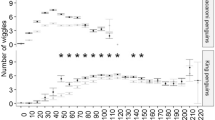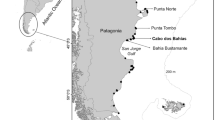Abstract
The diving ability of juvenile animals is constrained by their physiology, morphology and lack of experience, compared to adults. We studied the influences of age and mass on the diving behaviour of juvenile (2–3-year-old females, n = 12; 3–5-year-old males, n = 7) New Zealand (NZ) sea lions (Phocarctos hookeri) using time–depth recorders (TDRs) from 2008 to 2010 in the NZ subantarctic Auckland Islands. Diving ability (e.g. dive depth, duration and bottom time per dive) improved with age and mass. However, the percentage of each dive spent at the bottom, along with percentage time at sea spent diving, was comparable between younger and lighter juveniles and older and heavier juveniles. These suggest that younger and older juveniles expend similar foraging effort in terms of the amount of time spent underwater. Only, 5-year-old male juveniles dove to adult female depths and durations and had the highest foraging efficiency at depths >250 m. It appears that juvenile NZ sea lions attain adult female diving ability at around 5 years of age (at least in males), but prior to this, their performance is limited. Overall, the restricted diving capabilities of juvenile NZ sea lions may limit their available foraging habitat and ability to acquire food at deeper depths. The lower diving ability of juvenile NZ sea lions compared to adults, along with juvenile-specific constraints, should be taken into consideration for the effective management of this declining, nationally critical species.





Similar content being viewed by others
References
Baker JD, Donohue MJ (2000) Ontogeny of swimming and diving in northern fur seal (Callorhinus ursinus) pups. Can J Zool 78(1):100–109
Baker CS, Chilvers BL, Constantine R, DuFresne S, Mattlin RH, van Helden A (2010) Conservation status of New Zealand marine mammals (suborders Cetacea and Pinnipedia), 2009. N Z J Mar Freshwat Res 44(2):101–115. doi:10.1080/00288330.2010.482970
Bartoń K (2010) MuMIn: multi-model inference. R package, version 0.13.17
Baylis AMM, Page B, Peters K, McIntosh R, McKenzie J, Goldsworthy S (2005) The ontogeny of diving behaviour in New Zealand fur seal pups (Arctocephalus forsteri). Can J Zool 83(9):1149–1161
Beck CA, Bowen WD, McMillan JI, Iverson SJ (2003) Sex differences in diving at multiple temporal scales in a size-dimorphic capital breeder. J Anim Ecol 72(6):979–993
Brito JC (2004) Feeding ecology of Vipera latastei in northern Portugal: ontogenetic shifts, prey size and seasonal variations. Herp J 14(1):13–19
Burnham KP, Anderson DR (2002) Model selection and multimodel inference: a practical information-theoretic approach. Springer, New York
Burns JM (1999) The development of diving behavior in juvenile Weddell seals: pushing physiological limits in order to survive. Can J Zool 77(5):737–747
Burns JM, Schreer JF, Castellini MA (1997) Physiological effects on dive patterns and foraging strategies in yearling Weddell seals (Leptonychotes weddellii). Can J Zool 75(11):1796–1810
Caughley G (1966) Mortality patterns in mammals. Ecology 47(6):906–918
Chilvers BL, Mackenzie D (2010) Age and sex specific survival estimates incorporating tag loss for New Zealand sea lions, Phocarctos hookeri. J Mammal 91(3):758–767
Chilvers BL, Wilkinson IS, Duignan PJ, Gemmell NJ (2006) Diving to extremes: are New Zealand sea lions (Phocarctos hookeri) pushing their limits in a marginal habitat? J Zool 269:233–240
Chilvers BL, Robertson BC, Wilkinson IS, Duignan PJ (2007) Growth and survival of New Zealand sea lions, Phocarctos hookeri: birth to 3 months. Polar Biol 30:459–469
Costa DP, Gales NJ, Crocker DE (1998) Blood volume and diving ability of the New Zealand sea lion, Phocarctos hookeri. Physiol Zool 71(2):208–213
Costa DP, Gales NJ, Goebel ME (2001) Aerobic dive limit: how often does it occur in nature? Comp Biochem Physiol 129:771–783
Craig MP, Ragen TJ (1999) Body size, survival, and decline of juvenile Hawaiian monk seals, Monachus schauinslandi. Mar Mamm Sci 15(3):786–809
Daunt F, Afanasyev V, Adam A, Croxall JP, Wanless S (2007) From cradle to early grave: juvenile mortality in European shags Phalacrocorax aristotelis results from inadequate development of foraging proficiency. Biol Lett 3(4):371–374. doi:10.1098/rsbl 2007.0157
Fauchald P, Erikstad KE, Skarsfjord H (2000) Scale-dependent predator-prey interactions: the hierarchical spatial distribution of seabirds and prey. Ecology 81(3):773–783
Finkelstein ME, Doak DF, Nakagawa M, Sievert PR, Klavitter J (2010) Assessment of demographic risk factors and management priorities: impacts on juveniles substantially affect population viability of a long-lived seabird. Anim Conserv 13(2):148–156. doi:10.1111/j.1469-1795.2009.00311.x
Fowler SL, Costa DP, Arnould JPY, Gales NJ, Kuhn CE (2006) Ontogeny of diving behaviour in the Australian sea lion: trials of adolescence in a late bloomer. J Anim Ecol 75(2):358–367
Gales NJ (1995) New Zealand (Hooker’s) sea lion recovery plan. Threatened Species Recovery Plan Series 17. New Zealand Department of Conservation, Wellington, New Zealand
Gales NJ, Mattlin RH (1997) Summer diving behaviour of lactating New Zealand sea lions, Phocarctos hookeri. Can J Zool 75:1695–1706
Gales NJ, Mattlin RH (1998) Fast, safe, field-portable gas anesthesia for pinnipeds. Mar Mamm Sci 14:355–361
Halsey LG, Blackburn TM, Butler PJ (2006) A comparative analysis of the diving behaviour of birds and mammals. Funct Ecol 20:889–899
Horning M, Trillmich F (1997) Ontogeny of diving behaviour in the Galapagos fur seal. Behaviour 134:1211–1257
Irvine LG, Hindell MA, van den Hoff J, Burton HR (2000) The influence of body size on dive duration of underyearling southern elephant seals (Mirounga leonina). J Zool 251:463–471
IUCN (2011) IUCN Red List of Threatened Species. Version 2011.1. http://www.iucnredlist.org/. Accessed July 15 2011
Jeglinski JWE, Werner C, Robinson PW, Costa DP, Trillmich F (2012) Age, body mass and environmental variation shape the foraging ontogeny of Galapagos sea lions. Mar Ecol Prog Ser 453:279–296
Jenkins KJ, Barten NL (2005) Demography and decline of the Mentasta caribou herd in Alaska. Can J Zool 83(9):1174–1188. doi:10.1139/z05-111
Kohlmann SG, Risenhoover KL (1998) Effects of resource distribution, patch spacing, and preharvest information on foraging decisions of northern bobwhites. Behav Ecol 9(2):177–186
La Croix S, Zelditch ML, Shivik JA, Lundrigan BL, Holekamp KE (2011) Ontogeny of feeding performance and biomechanics in coyotes. J Zool 285(4):301–315. doi:10.1111/j.1469-7998.2011.00847.x
Le Boeuf BJ, Morris PA, Blackwell SB, Crocker DE, Costa DP (1996) Diving behavior of juvenile northern elephant seals. Can J Zool 74(9):1632–1644
Leung ES, Chilvers BL, Nakagawa S, Moore A, Robertson BC (2012) Sexual segregation in juvenile New Zealand sea lion foraging ranges: implications for intraspecific competition, population dynamics and conservation. PLoS One 7(9):e45389. doi:10.1371/journal.pone.0045389
Leung ES, Chilvers BL, Moore AB, Robertson BC (2013) Mass and bathymetry influences on the foraging behaviour of dependent yearling New Zealand sea lions (Phocarctos hookeri). N Z J Mar Freshwat Res 47(1):38–50. doi:10.1080/00288330.2012.732584
Loughlin TR, Sterling JT, Merrick RL, Sease JL, York AE (2003) Diving behavior of immature Steller sea lions (Eumetopias jubatus). Fish Bull 101(3):566–582
Luque SP (2007) Diving behavior analysis in R. R News 7(3):8–14
McCafferty DJ, Boyd IL, Taylor RI (1998) Diving behaviour of Antarctic fur seal (Arctocephalus gazella) pups. Can J Zool 76(3):513–520
Merrick RL, Loughlin TR (1997) Foraging behavior of adult female and young-of-the-year Steller sea lions in Alaskan waters. Can J Zool 75(5):776–786
Meynier L, Mackenzie DDS, Duignan PJ, Chilvers BL, Morel PCH (2009) Variability in the diet of New Zealand sea lion (Phocarctos hookeri) at the Auckland Islands. New Zealand. Mar Mamm Sci 25(2):302–326
Millar JS, Hickling GJ (1990) Fasting endurance and the evolution of mammalian body size. Funct Ecol 4(1):5–12. doi:10.2307/2389646
Owen-Smith N (1990) Demography of a large herbivore, the greater kudu Tragelaphus strepsiceros, in relation to rainfall. J Anim Ecol 59(3):893–913. doi:10.2307/5021
Pinheiro J, Bates D, DebRoy S, Sarkar D, R Development Core Team (2010) nlme: linear and nonlinear mixed effects models. R package, version 3.1-97
Pitcher KW, Rehberg MJ, Pendleton GW, Raum-Suryan KL, Gelatt TS, Swain UG, Sigler MF (2005) Ontogeny of dive performance in pup and juvenile Steller sea lions in Alaska. Can J Zool 83:1214–1231
R Development Core Team (2010) R: a language and environment for statistical computing. R Foundation for Statistical Computing, Vienna
Raum-Suryan KL, Rehberg MJ, Pendleton GW, Pitcher KW, Gelatt TS (2004) Development of dispersal, movement patterns and haul-out use by pup and juvenile Steller sea lions (Eumetopias jubatus) in Alaska. Mar Mamm Sci 20(4):823–850
Rehberg MJ, Burns JM (2008) Differences in diving and swimming behaviour of pup and juvenile Steller sea lions (Eumetopias jubatus) in Alaska. Can J Zool 86:539–553
Robertson BC, Chilvers BL (2011) The population decline of the New Zealand sea lion Phocarctos hookeri: a review of possible causes. Mamm Rev 41(4):253–275. doi:10.1111/j.1365-2907.2011.00186.x
Ruckstuhl KE, Neuhaus P (eds) (2005) Sexual segregation in vertebrates: ecology of the two sexes. Cambridge University Press, Cambridge
Schielzeth H (2010) Simple means to improve the interpretability of regression coefficients. Methods Ecol Evol 1:103–113
Schreer JF, Kovacs KM (1997) Allometry of diving capacity in air-breathing vertebrates. Can J Zool 75(3):339–358
Wearmouth VJ, Sims DW (2008) Sexual segregation in marine fish, reptiles, birds and mammals: behaviour patterns, mechanisms and conservation implications. Adv Mar Biol 54:107–170. doi:10.1016/s0065-2881(08)00002-3
Weathers WW, Sullivan KA (1989) Juvenile foraging proficiency, parental effort and avian reproductive success. Ecol Monogr 59(3):223–246. doi:10.2307/1942600
Weise MJ (2006) Foraging ecology of male California sea lion (Zalophus californianus): movement, diving and foraging behavior, and diving capacity. Dissertation, University of California, Santa Cruz
Wildhaber ML, Crowder LB (1991) Mechanisms of patch-choice by bluegills (Lepomis macrochirus) foraging in a variable environment. Copeia 2:445–460
Winship AJ, Trites AW, Rosen DAS (2002) A bioenergetic model for estimating the food requirements of Steller sea lions Eumetopias jubatus in Alaska, USA. Mar Ecol Prog Ser 229:291–312. doi:10.3354/meps229291
Ydenberg RC, Clark CW (1989) Aerobiosis and anaerobiosis during diving by Western Grebes—an optimal foraging approach. J Theor Biol 139(4):437–447
Acknowledgments
We thank A. Augé, L. Boren, H. McConnell, J. Amey, W. Roe, L. Meynier, K. Geschke, R. Hood, J. Fyfe, K. McInnes, N. McNally, G. Oakes and M. Riki for their assistance with animal captures. We are grateful to A. Jacob, S. Townsend, D. Jones, G. McDonald, S. Childerhouse and anonymous reviewers for their helpful comments on this manuscript. Data presented in this paper were collected from a long-term study funded by the New Zealand Department of Conservation (DOC) investigation no. 1638, in parallel with fieldwork undertaken for the DOC Conservation Services Program (DOC project Pop 2007/01; http://www.doc.govt.nz/conservation/marine-and-coastal/commercial-fishing/conservation-services-programme/) and through a levy principally on the quota holders of SQU6T. Funding was also provided by the University of Otago Zoology Department. Animal Ethics Committee Approval: DOC AEC158 (10 December 2007), DOC AEC 200 (2 November 2009) and University of Otago AEC 28/10. E.L. was supported by the University of Otago Postgraduate Scholarship.
Author information
Authors and Affiliations
Corresponding author
Rights and permissions
About this article
Cite this article
Leung, E.S., Chilvers, B.L., Nakagawa, S. et al. Size and experience matter: diving behaviour of juvenile New Zealand sea lions (Phocarctos hookeri). Polar Biol 37, 15–26 (2014). https://doi.org/10.1007/s00300-013-1405-6
Received:
Revised:
Accepted:
Published:
Issue Date:
DOI: https://doi.org/10.1007/s00300-013-1405-6




